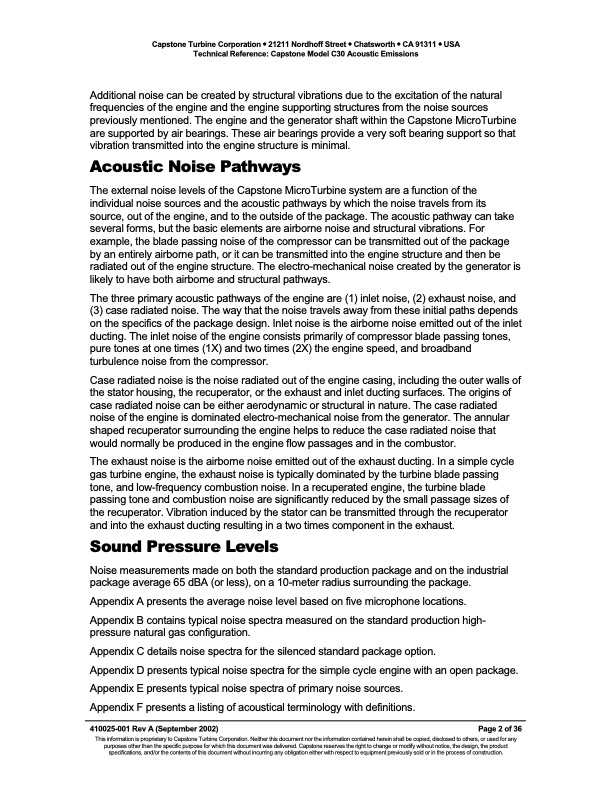
PDF Publication Title:
Text from PDF Page: 002
Capstone Turbine Corporation • 21211 Nordhoff Street • Chatsworth • CA 91311 • USA Technical Reference: Capstone Model C30 Acoustic Emissions Additional noise can be created by structural vibrations due to the excitation of the natural frequencies of the engine and the engine supporting structures from the noise sources previously mentioned. The engine and the generator shaft within the Capstone MicroTurbine are supported by air bearings. These air bearings provide a very soft bearing support so that vibration transmitted into the engine structure is minimal. Acoustic Noise Pathways The external noise levels of the Capstone MicroTurbine system are a function of the individual noise sources and the acoustic pathways by which the noise travels from its source, out of the engine, and to the outside of the package. The acoustic pathway can take several forms, but the basic elements are airborne noise and structural vibrations. For example, the blade passing noise of the compressor can be transmitted out of the package by an entirely airborne path, or it can be transmitted into the engine structure and then be radiated out of the engine structure. The electro-mechanical noise created by the generator is likely to have both airborne and structural pathways. The three primary acoustic pathways of the engine are (1) inlet noise, (2) exhaust noise, and (3) case radiated noise. The way that the noise travels away from these initial paths depends on the specifics of the package design. Inlet noise is the airborne noise emitted out of the inlet ducting. The inlet noise of the engine consists primarily of compressor blade passing tones, pure tones at one times (1X) and two times (2X) the engine speed, and broadband turbulence noise from the compressor. Case radiated noise is the noise radiated out of the engine casing, including the outer walls of the stator housing, the recuperator, or the exhaust and inlet ducting surfaces. The origins of case radiated noise can be either aerodynamic or structural in nature. The case radiated noise of the engine is dominated electro-mechanical noise from the generator. The annular shaped recuperator surrounding the engine helps to reduce the case radiated noise that would normally be produced in the engine flow passages and in the combustor. The exhaust noise is the airborne noise emitted out of the exhaust ducting. In a simple cycle gas turbine engine, the exhaust noise is typically dominated by the turbine blade passing tone, and low-frequency combustion noise. In a recuperated engine, the turbine blade passing tone and combustion noise are significantly reduced by the small passage sizes of the recuperator. Vibration induced by the stator can be transmitted through the recuperator and into the exhaust ducting resulting in a two times component in the exhaust. Sound Pressure Levels Noise measurements made on both the standard production package and on the industrial package average 65 dBA (or less), on a 10-meter radius surrounding the package. Appendix A presents the average noise level based on five microphone locations. Appendix B contains typical noise spectra measured on the standard production high- pressure natural gas configuration. Appendix C details noise spectra for the silenced standard package option. Appendix D presents typical noise spectra for the simple cycle engine with an open package. Appendix E presents typical noise spectra of primary noise sources. Appendix F presents a listing of acoustical terminology with definitions. 410025-001 Rev A (September 2002) Page 2 of 36 This information is proprietary to Capstone Turbine Corporation. Neither this document nor the information contained herein shall be copied, disclosed to others, or used for any purposes other than the specific purpose for which this document was delivered. Capstone reserves the right to change or modify without notice, the design, the product specifications, and/or the contents of this document without incurring any obligation either with respect to equipment previously sold or in the process of construction.PDF Image | Guide for Capstone Turbine Model Number

PDF Search Title:
Guide for Capstone Turbine Model NumberOriginal File Name Searched:
410025_C30_Acoustics.pdfDIY PDF Search: Google It | Yahoo | Bing
Capstone Turbine and Microturbine: Capstone microturbines used and new surplus for sale listing More Info
Consulting and Strategy Services: Need help with Capstone Turbine, sizing systems, applications, or renewable energy strategy, we are here to assist More Info
Container Lumber Dry Kiln: Since 1991 developing and innovating dry kilns using standard shipping containers More Info
Supercritical CO2 Lumber Dry Kiln: Compact fast drying in 3 days or less for small amounts of wood and lumber drying More Info
BitCoin Mining: Bitcoin Mining and Cryptocurrency... More Info
Publications: Capstone Turbine publications for microturbine and distributed energy More Info
FileMaker Software for Renewable Energy Developing database software for the renewable energy industry More Info
CO2 Gas to Liquids On-Demand Production Cart Developing a supercritical CO2 to alcohol on-demand production system (via Nafion reverse fuel cell) More Info
Stranded Gas for low cost power Bitcoin Mining Using stranded gas for generators may provide breakthrough low power costs for cryptocurrency miners. More Info
| CONTACT TEL: 608-238-6001 Email: greg@globalmicroturbine.com | RSS | AMP |